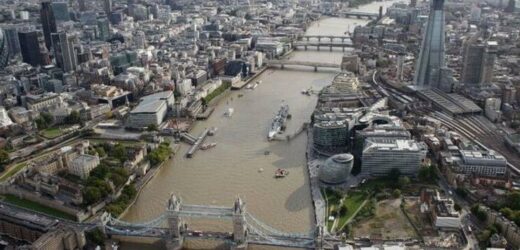Climate change: Boris Johnson's 'targets' questioned by Menon
We use your sign-up to provide content in ways you’ve consented to and to improve our understanding of you. This may include adverts from us and 3rd parties based on our understanding. You can unsubscribe at any time. More info
Paracetamol, hay fever medication and drugs used to treat epilepsy are among the pharmaceuticals contaminating Britain’s rivers. Antibiotics are also making their way into the country’s waterways, endangering wildlife and threatening to drive up antimicrobial resistance in humans. The pollution is caused when sewage containing the drugs is released into rivers by water companies.
Scientists led by a team from the University of York found pharmaceuticals in all of the eight rivers they tested in the UK, including the Thames, the Clyde and the Ouse.
The research, which studied 100 countries around the world, revealed Britain to have the highest levels of pollution by multiple drugs in Europe.
It came out on top for sites where levels of at least one drug exceeded those thought to be safe for aquatic life or antimicrobial resistance in humans.
Dr John Hopkinson, who led the study, said the pollution by antibiotics posed the biggest threat to humans as antimicrobial resistance is already driving up mortality around the world.
He said: “A bacterial community exposed to an antibiotic at a tiny fraction of this can develop resistance to an antibiotic medicine. In my perspective, this is the aspect where the ‘threat’ is most significant.
“There is evidence showing that antimicrobial resistance is already causing deaths globally. The environmental component of this is something we’re just beginning to understand is a significant factor in this urgent public health threat.”
The other riskiest drugs found in the country’s rivers are propranolol, a beta-blocker prescribed for anxiety, migraines and heart problems, metformin, which is used to treat type 2 diabetes, and medicines used to treat epilepsy and nerve pain, which Dr Hopkinson said affect fish reproduction and growth.
He said: “We typically see pharmaceuticals including carbamazepine (used to treat epilepsy and nerve pain) and metformin (used to treat type 2 diabetes) most frequently in the UK.
“There have been studies suggesting endocrine and reproductive dysfunction in fish exposed to such chemicals but usually at concentrations above what we observe in the UK.”
Other drugs included fexofenadine, a hay fever treatment, paracetamol and caffeine.


However, he noted that humans would have to ingest a huge volume of river water to receive a therapeutic dose of any of the drugs.
He said: “For example, a person would have to drink over 2000 L of river water (more so than the human body can safely cope with) containing paracetamol (more commonly known as acetaminophen in the USA) at the highest concentration observed in our study in order to simply reach a therapeutic dose of the drug.”
Dr Hopkinson said the main source of pharmaceutical pollution in UK rivers was sewage outflows.
He said: “The basic route of pharmaceutical exposure is via inadequate disposal or treatment of waste.
“When we consume any chemical (e.g., caffeine in our coffee, painkillers, prescriptions, etc) our bodies will not completely metabolise these chemicals before we expel them and they are routed to the sewage treatment system.
“Modern sewage treatment plants are not 100 percent effective at breaking down these chemicals and ultimately, some of everything we put through our bodies will make it into our rivers.”
The study looked at 258 rivers around the world, including 54 locations in the UK.
It revealed that pharmaceutical pollution is contaminating water on every continent and at potentially toxic levels in more than a quarter of locations studied.
READ MORE: National Trust urges Britons to plant trees for Platinum Jubilee


Dr Hopkinson said: “Usually the amount making their way into rivers is not enough to worry about. However what we’ve found is that in many places around the world (even in North America and Europe who have among the best sewage systems in the world) that raw, untreated sewage can get into the water and elevate concentrations and ecological risk.
“This can happen on purpose usually down to poor regulation: for example we found trucks sucking up the contents of septic tanks in the city of Nairobi at times will dump their contents in local rivers rather than taking it to overstretched treatment facilities.”
He also said that people disposing of their left over drugs down drains was driving up pollution.
The researchers found that the UK had the highest number of different chemicals in its rivers compared to the rest of Europe.
The River Clyde in Scotland was found to contain 31 out of 61 medicines included in the study while the Thames held 26.
Dr Wilkinson urged people to dispose of their drugs by taking them to the pharmacy to go towards tackling the problem.
He said: “A lot can be done on a personal level. Rather than flushing old pharmaceuticals (which somewhat surprisingly people actually do) or throwing them in landfills, you can actually bring them back to most pharmacies where they’ll be safely disposed of.”
He continued: “We have the solutions on a larger scale to combat this issue as well. We know that good sewage connectivity and wastewater treatment are key to driving down environmental concentrations.”
DON’T MISS:
Brexit LIVE: Petty remark exposes Brussels refusal to wake up [LIVE]
Cancer symptoms: The ‘persistent’ sign when waking up in the morning [INSIGHT]
Ukraine evacuation begins: Deafening sirens order residents to leave [LATEST]

He explained the problem will only get worse as populations grow and areas become more densely populated.
Dr Wilkinson said: “As our populations increase and become more densely urbanised, our impact on the water around us will also increase. Namely, as more of our waste enters the aquatic environment there will be rises in both the concentrations and consequent risk we observe.”
Dr Rob Collins, science and policy director at the Rivers Trust, said: “The Rivers Trust is very concerned by these findings, and they help to confirm that many of our rivers are now polluted by a cocktail of different chemicals, including pharmaceuticals.
“Not only does this seriously threaten our freshwater ecosystems, the literally hundreds of chemicals found in our rivers also raise a risk to public health too.”
He continued: “Numerous studies have shown that the pharmaceuticals found in our rivers, such as antidepressants, painkillers, and hormones, have several detrimental impacts upon aquatic life, affecting reproduction, behaviour and food cycles.
“The widespread presence of antibiotics is also likely to exacerbate antimicrobial resistance in our environment; resistant bacteria are now widely found in wastewater, agricultural soils and beaches.”
Dr Collins agreed people could limit their pharmaceutical pollution by better disposing of their unused drugs and called for greater investment to sure-up wastewater treatment.
He said: “Greater investment is needed into wastewater treatment infrastructure to improve the removal of pharmaceuticals, and nature-based solutions such as wetlands and reedbeds also have a role to play here.
“Awareness needs to be raised of medicine take back schemes whereby unwanted drugs are returned to the pharmacy rather than flushed down the toilet.”
Source: Read Full Article


